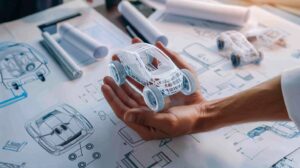Technology

Technology in today’s car market explains very much about the value of your car, its performance, and its appeal. While comparing cars with each other, a fair knowledge of technology aspects and updates will always come in handy. This guide discusses in detail the different technological aspects to consider during car comparisons that can enable you to make a better choice.
Why Technology is Crucial in Modern Cars
Safety Enhanced
Modern cars come fitted with state-of-the-art safety technologies that make them less accident-prone while at the same time being more protective of their occupants. Features like automatic emergency braking, lane-keeping assist, and blind-spot monitoring are quite common in most vehicles.
Better Performance and Efficiency
The engine efficiency, better mileage, and increased performance resulted from the advent of technology. Turbocharging, hybrid powertrains, and electric motors show how technology improves both performance and efficiency.
Comfort and Convenience
From adaptive cruise control to state-of-the-art infotainment, it is technology that gives comfort and convenience a new look from behind the wheel. It is things like voice-activated controls, smartphone integration, and wireless charging that further enhance driving enjoyment.
Key Tech Features to Compare
Infotainment Systems
The infotainment system is arguably the most crucial tech feature in a car. When comparing cars, consider this:
- Screen Size and Resolution: Larger, high-resolution screens provide better visibility and ease of operation.
- User Interface: The availability of intuitive and user-friendly interfaces to some extent facilitates access to features.
- Connectivity: Apple CarPlay, Android Auto, Bluetooth, and Wi-Fi
Advanced Driver Assistance Systems (ADAS)
ADAS features enhance safety and driving convenience. Some of the key systems that are worthy of comparison with each other in cars include:
- Adaptive Cruise Control: This system keeps a chosen speed and distance from the vehicle in front.
- Lane-Keeping Assist: This function helps the car stay in its lane.
- Blind-Spot Monitoring: This function alerts the driver when there is another vehicle driving in his/her blind spot.
- Autonomous Emergency Braking: This safety feature engages the brakes automatically to prevent an accident.
Powertrain Technology
The powertrain is indeed the heart of performance for any car. Compare the following:
- Engine Type: Turbocharged, naturally aspirated, hybrid, and electric
- Transmission: Automatic, manual, or CVT
- Fuel Efficiency: MPG ratings against competing models
Connectivity and Integration
Connected cars today come in different forms, supporting integration through connectivity options, each of which takes the car ride experience to the next level, including:
- Smartphone Integration: Phones are tightly integrated with the ability to make calls, send messages, and even apps via the car’s interface itself.
- Navigation Systems: Inbuilt GPS navigation with real-time traffic updates.
- Voice Recognition: Hands-free control of various functions.
Comfort and Convenience Features
Technological features that enhance comfort and convenience include:
- Climate Control: Dual-zone or tri-zone climate control for personalized comfort.
- Seating Adjustments: Power-adjustable seats with memory functions.
- Keyless Entry and Start: Convenient access and ignition without a traditional key.
Evaluating Infotainment Systems

Display Quality and Size
Good resolution and high picture quality display all information clear and readable. Larger screens give more real estate for maps, media, and other data.
Ease of Use
The interface shall be user-friendly, having easy controls that would enable the driver to use the system easily without moving the attention away from driving. Touchscreens, buttons, and voice controls all contribute to the system’s ease of use.
Connectivity Options
Connectivity via Bluetooth, USB ports, and integration of smartphones are some of the essential features of an entertainment system. They provide easy, quick ways to link various devices and use them efficiently.
Advanced Driver-Assistance Systems (ADAS)

Safety Benefits
ADAS features enhance safety substantially in many scenarios by facilitating the driver’s better perception and control. Automatic emergency braking ensures no collision, while lane-keeping assist keeps your vehicle in the right lane.
Convenience and Ease in Driving
Adaptive cruise control and blind-spot monitoring are some of the systems that make driving easy while also less stressful. These systems lighten the workload on the driver and create more safety factors.
Powertrain and Performance

Engine Types and Configurations
The type of engine is one of the major factors in relation to a car’s performance and efficiency. Compare options such as turbocharged engines for more power and hybrid or electric powertrains for better fuel economy.
Transmission Types
Various transmissions offer different driving experiences. To that effect, automatics are convenient, while manuals increase driver involvement. However, CVTs improve on efficiency without sacrificing smooth driving.
Fuel Efficiency and Emissions
Fuel efficiency is an important consideration, mainly due to the ever-rising prices of fuel and environmental concerns. Compare MPG ratings and emissions across cars to find an eco-friendly choice.
Connectivity and Integration

Smartphone Integration
This allows for seamless smartphone integration through Apple CarPlay and Android Auto, which provides several operations available on a person’s phone to be controlled by the infotainment display, making it safe and easy to do.
Navigation and Real-Time Updates
Built-in navigation systems that include real-time traffic updates enable drivers to bypass delays and suggest the best route. These systems are usually more accurate and up-to-date than using maps on a person’s smartphone.
Voice Control Systems
Voice control systems make every function hands-free and, therefore, much safer, as drivers can now keep both hands on the wheel and eyes on the road.
Comfort and Convenience Technologies

Climate Control Systems
State-of-the-art climate control systems—dual-zone and tri-zone—are the ones that enable different car areas to have different temperatures, thus ensuring comfort to each passenger.
Seating Comfort and Adjustments
Power-adjusted seats with memory functions personalize comfort settings for various drivers. Heated and ventilated seats enhance the luxury and comfort of the car.
Keyless Entry and Push-Button Start
Keyless entry and push-button start systems provide convenience to the driver by allowing him to enter and start the car without having to dig deep in his pocket in search of keys.
Future Trends in Car Technology

Autonomous Driving
Autonomous driving technology is fast evolving, with features such as self-parking and highway autopilot making a gradual entry onto the roads. In the future, fully autonomous driving will probably be an offer on most cars.
Electric and Hybrid Technologies
Increased focus on lower emissions and fuel economy has made every manufacturer start developing electric and hybrid powertrains more. A couple of these models would start being more common in the near future.
Augmented Reality Displays
AR displays the project information on the windscreen itself, thereby leaving the driver with all the requisite data without having to remove his eyes from the road. This enhances safety and convenience.
Conclusion
With the modern world, car comparisons cannot be done without technology. Hence, understanding and evaluation of most of the available technological features will give a clear insight into what can suit one. Since new automotive technology is launched all the time, keeping current with the trends and developments keeps you always a step ahead.
FAQs
- Which technological features of the car are most important to compare?
Infotainment systems, advanced driver assistance systems, power-train technology, connectivity options, comfort and convenience features.
- How have advanced driver-assistance systems improved safety?
Technologies that reduce the potential for human error, such as Automatic Emergency Braking, Lane-Keeping Assist, Adaptive Cruise Control—make driving easier, much less stressful, and even safe by reducing accident risk.
- Why is fuel efficiency important in car comparisons?
Fuel efficiency spells out how much running costs will be, as well as the environmental impact. Comparing MPG ratings will let one pick a car that can save him money and the environment.
- What is the role of connectivity in today’s cars?
Connectivity options, like smartphone integration, on-board navigation, and voice control, let one drive more conveniently and delightfully due to access to information and entertainment at one’s fingertips.
- What are some future trends on car technology I need to look oufor?
These involve autonomous driving, electric and hybrid powertrains, and augmented reality displays, which give way to a revolution in the automotive sector.
